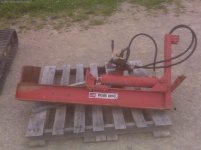Well now, that's impressive! It would seem to say that 1/4" hoses are as good as 1/2" hoses as long as the restriction didn't produce enough backpressure to open the PRV. A restrictor orifice of 0.030" would slow flow only because it caused maximum pressure and PRV opening. That sure makes a properly working PRV important to flow control in a fixed displacement pump system.
That is right!
But a 1/4" hose will create a increased pressure that will cause a power loss as HEAT....
All restriction causes power losses as heat if there is a flow present...
A restriction on the work port CAN make it easier to FEATHER or METER the CV...
FEATHER means DIVIDE FLOW between WORK PORT and the partly OPEN CENTER...
That means a RESTRICTOR will work well as FLOW CONTROL as long we DO NOT FULLY CLOSE THE CENTER of the control valve
So there are basically 3 options that can happen with a restrictor as flow control on the work port....
1. With CV center fully closed, no change in flow, and pump pressure is below PRV setting
2. With CV center fully closed, pump pressure at PRV setting and restrictor will deliver a reduced flow through work port
3. With CV center partly closed, pump pressure below OR at PRV setting and restrictor will deliver a reduced flow through the work port
NOTE: Flow through the restrictor is dependent on the differential pressure (delta P) over the restrictor....pump pressure minus load pressure....which means that if load pressure changes flow trough restrictor will change as well


